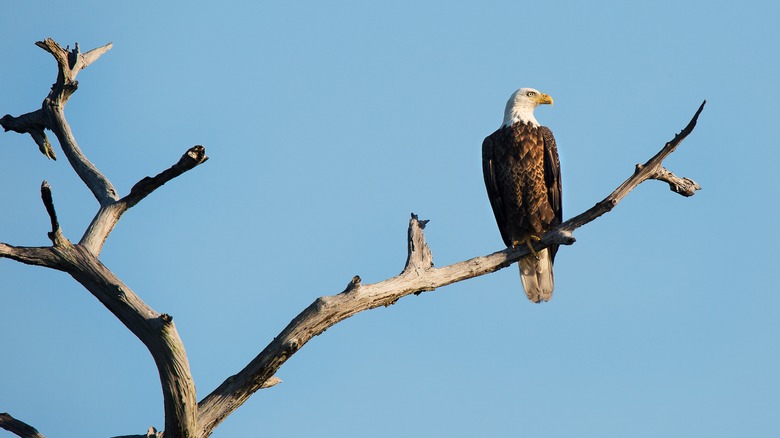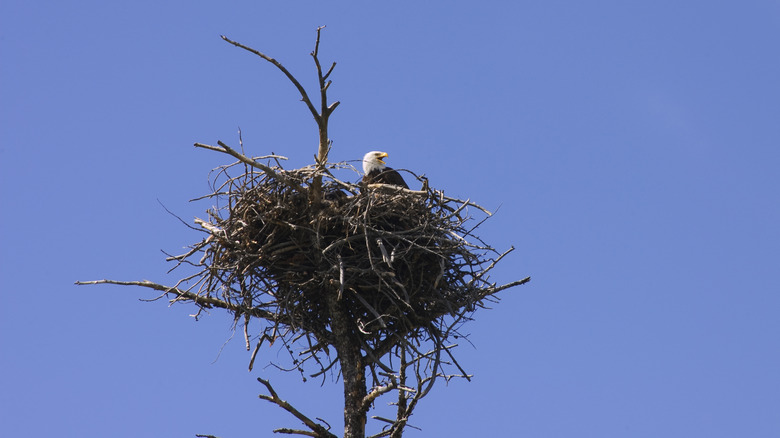Why It's Illegal To Own A Bald Eagle Feather
Despite being harmless in itself, the taking of a bald eagle feather is technically illegal. Worse, it's a crime that could land you a hefty fine — or even prison time. According to the U.S. Fish and Wildlife Service, it is part of a general ban on the possession or trade of bald eagles in any form and is part of the effort to protect the species.
The extremity of the penalties reflects the severity of the bald eagles' plight in the early- to mid-20th century. Skillful predator raptors, bald eagles are adept at taking prey from a variety of wild animals. They will also target farm animals such as chickens if given the chance. As a consequence, farmers looking to protect their livestock shot them with abandon for generations, leading to their rapid decline. Another threat to the species was harmful pesticides, such as DDT, which were widely used for decades up until they were banned in the 1960s.
The effect on bald eagle populations was staggering. Back in 1782, when the bald eagle was first adopted as the national bird of the United States, it is believed there may have been around 100,000 living free across the country, per the Environmental Defense Fund. By the 1960s, Audubon says there was only 1% of this number breeding in the wild. In some areas, such as the Channel Islands National Park, the species was wiped out entirely.
The Acts that Mattered
With the bald eagle edging ever closer to extinction, it was time to take decisive action. In 1940, the U.S. government enacted the Bald and Golden Eagle Protection Act — later expanded to include golden eagles — which in its wide-ranging scope prohibits anyone to "take, possess, sell, purchase, barter, offer to sell, purchase or barter, transport, export or import, at any time or any manner, any bald [or golden] eagle ... alive or dead, or any part (including feathers), nest, or egg thereof[.]" Penalties run to tens of thousands of dollars for a first offense. The bald eagle is also protected internationally by the Migratory Bird Treaty Act, which has expanded its scope repeatedly since first being introduced in 1918.
Similarly, the Endangered Species Act of 1973 was highly impactful in limiting the use of pesticides like DDT that affect wildlife, including the bald eagle.
There are some notable exceptions
The story of the bald eagle in America encompasses the species' becoming the United States' national bird, its eventual decline as a result of farmers protecting agriculture, and more recent steps to protect it and see it thrive once again. The bald eagle of course features heavily in the traditional cultures of several Native American tribes, and the bald eagle feather in particular is a crucial element in a number of tribal rituals and ceremonies.
It also goes without saying that there may occasionally be legitimate scientific uses for bald eagle specimens, which may in the long run help to secure the species in the U.S. for future generations. Therefore, The Bald and Golden Eagle Protection Act makes special provisions for certain groups— like Native Americans and scientists — with a reasonable use for bald eagle feathers to apply for a permit by which they may "take" samples under certain conditions. However, the sale and trade of bald eagle parts remain entirely outlawed.
Thanks to the acts outlined above, bald eagle populations have begun to recover across the U.S., with an astounding 300,000 believed to be present in the country, according to data gathered in 2018 and 2019, per the U.S. Fish & Wildlife Service. This includes scores of new breeding pairs resident in the Channel Islands National Park thanks to successful conservation efforts in recent decades.


